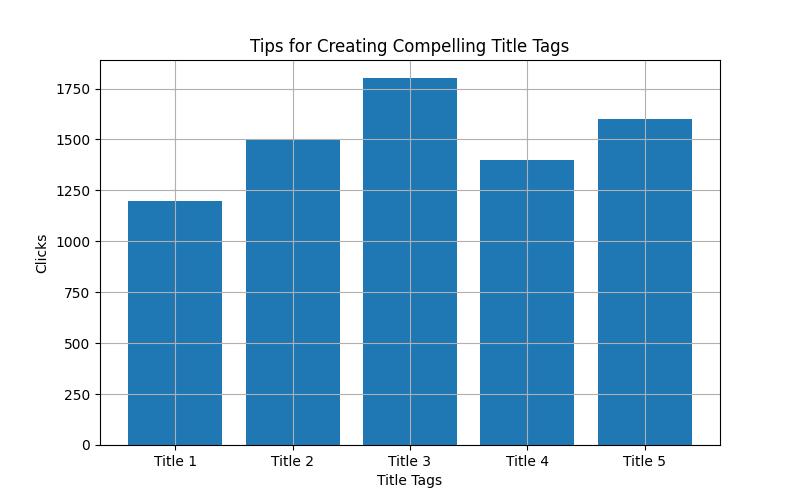What You Will Learn About Title Tag Optimization in SEO and Digital Marketing
- Definition and importance of title tags in SEO and digital marketing
- How title tags impact search engine rankings and click-through rates
- The role of title tags in providing a concise description of a webpage
- The HTML structure and syntax of title tags
- Strategies for optimizing title tags for SEO and effective keyword placement
- Tips for crafting compelling and click-worthy titles
- Ensuring relevance and clarity in title tags for search engines and users
- The negative impact of duplicate title tags on SEO performance
- Utilizing title tags to strengthen brand identity and consistency
- Ideal length and conciseness in title tags
- HTML best practices and avoiding spammy tactics in title tags
- A/B testing and optimization techniques for title tags
- Optimizing title tags for mobile devices and responsive design
- Tracking and analytics for monitoring title tag performance
- Updates and maintenance of title tags to align with SEO trends
- Common mistakes to avoid in title tags
- Frequently asked questions and additional resources for title tag optimization
Title tags play a crucial role in search engine optimization (SEO) and digital marketing. They are HTML elements that provide concise and descriptive information about a webpage. Title tags not only impact search engine rankings but also significantly influence click-through rates. In this article, we will delve into the importance of title tags and explore how they can supercharge your SEO efforts and digital marketing strategies.

Understanding the Purpose of Title Tags
Title tags serve as the first impression for search engine users. When a user performs a search, the title tag appears as the clickable headline in the search engine results pages (SERPs). It provides a brief preview of what the webpage contains. A well-crafted title tag can entice users to click and visit your website. Therefore, it is essential to understand the purpose of title tags and optimize them effectively.
The HTML Structure of Title Tags
Title tags are written in HTML and have a specific structure. They are enclosed within the <title></title> tags and placed within the head section of a webpage. It is crucial to follow proper formatting and syntax when creating title tags. This includes using relevant keywords, separating the title from the brand name with a pipe or dash, and maintaining an appropriate length.

Optimizing Title Tags for SEO
Keyword optimization is a vital aspect of title tag optimization. By strategically placing relevant keywords within your title tags, you can improve your search engine rankings. Conducting thorough keyword research is essential to identify the most relevant and high-performing keywords for your target audience. Integrate these keywords naturally into your title tags to maximize their SEO impact.

Crafting Compelling and Click-Worthy Titles
Creating catchy and attention-grabbing titles is crucial to drive click-through rates. A compelling title tag should pique the interest of search engine users and entice them to click on your website. To achieve this, use power words, include numbers or statistics, and convey a sense of urgency or exclusivity. Tailor your title tags to different industries and experiment with different formulas to find what works best for your target audience.
Examples of Successful Title Tag Formulas for Different Industries:
- E-commerce: “Shop the Best Deals: [Brand Name] Offers Up to 50% Off Today!”
- Travel: “Discover the Hidden Gems of [Destination] – Your Ultimate Travel Guide”
- Technology: “Stay Ahead of the Game with [Brand Name]’s Cutting-Edge Innovations”
- Health and Fitness: “Transform Your Body and Mind: [Brand Name]’s Revolutionary Fitness Program”
Case Study: How Optimizing Title Tags Boosted Website Traffic by 50%
Introduction
In this case study, we will explore how a small online retail store, “Fashion Haven,” implemented title tag optimization strategies to significantly increase their website traffic and improve their search engine rankings. By following the best practices discussed in this article, Fashion Haven was able to supercharge their SEO and digital marketing efforts.
The Challenge
Fashion Haven, a boutique fashion store specializing in trendy clothing and accessories, was struggling to attract organic traffic to their website. Despite having a visually appealing and user-friendly website, they were not ranking well in search engine results pages (SERPs). Recognizing the importance of title tags in SEO, the team at Fashion Haven decided to optimize their title tags to improve their online visibility.
The Solution
Fashion Haven began by conducting thorough keyword research to identify the most relevant and high-performing keywords for their industry. They then incorporated these keywords strategically into their title tags, ensuring that each tag accurately described the content of the corresponding webpage.
Results and Impact
After implementing the optimized title tags, Fashion Haven saw a remarkable increase in their website traffic. Within just three months, their organic search traffic grew by 50%, resulting in a significant boost in sales and revenue. Additionally, their search engine rankings improved, with many of their webpages appearing on the first page of SERPs for their target keywords.
Key Takeaways
This case study highlights the importance of title tag optimization in driving organic traffic and improving search engine rankings. By following the strategies outlined in this article, Fashion Haven was able to achieve remarkable results and establish a strong online presence in a competitive industry.

Ensuring Relevance and Clarity in Title Tags
Relevance and clarity are crucial when optimizing title tags. It is essential to align your title tags with the content of the webpage and the user’s search intent. Irrelevant or misleading title tags can lead to a high bounce rate and negatively impact your SEO performance. Make sure your title tags accurately represent what the webpage offers and provide a clear indication of what users can expect when they click through.
The Impact of Unique Title Tags
Duplicate title tags can harm your SEO performance. Search engines may view pages with identical title tags as duplicate content, leading to lower rankings. To avoid this, create unique and descriptive title tags for each page on your website. Each title tag should accurately reflect the content and purpose of the specific webpage it represents. By doing so, you can improve your search engine visibility and attract more relevant traffic.
Branding and Consistency in Title Tags
Title tags provide an excellent opportunity to strengthen your brand identity and recognition. Incorporate your brand name or relevant keywords related to your brand in the title tags. Consistency in title tags across your webpages and marketing campaigns helps create a cohesive and recognizable brand experience for users. This consistency also helps search engines understand your brand and associate it with relevant keywords and topics.
Length and Conciseness in Title Tags
The ideal length of title tags is approximately 50-60 characters, including spaces. This ensures that the entire title tag is visible in the search engine results without being cut off. Being concise while effectively conveying the main message of the webpage is key. Avoid stuffing your title tags with unnecessary keywords or information that may dilute the impact. Instead, focus on creating a concise and compelling headline that captures the essence of the webpage.
HTML Best Practices for Title Tags
Following HTML best practices when implementing title tags is crucial for optimal performance. Ensure that your title tags are properly formatted and adhere to HTML syntax rules. Use proper character encoding to avoid any display issues or rendering problems. It is also important to avoid spammy tactics, such as excessive use of capital letters, excessive repetition of keywords, or using irrelevant or misleading titles. These practices can harm your SEO efforts and user experience.
A/B Testing and Optimization of Title Tags
A/B testing is a valuable technique for optimizing title tags. By creating different versions of your title tags and measuring their performance, you can identify the most effective ones. Analyzing click-through rates and user engagement metrics can provide valuable insights into which title tags resonate best with your target audience. Continuously optimize and refine your title tags based on the results of A/B testing to maximize their impact.
Mobile Optimization of Title Tags
In today’s mobile-dominated world, optimizing title tags for mobile devices is crucial. Mobile search behavior differs from desktop search behavior, and users have limited screen space to view search results. Ensure that your title tags are concise and display properly on mobile devices. Consider the user journey and adapt your title tags to align with mobile user behavior and responsive design principles. This will enhance the user experience and drive more mobile traffic to your website.
Tracking and Analytics for Title Tags
Tracking the performance of your title tags is essential to gauge their effectiveness. Utilize SEO analytics tools to monitor metrics such as click-through rates, bounce rates, and conversions associated with your title tags. Analyzing this data will provide valuable insights into the performance of your title tags and help you make data-driven decisions for improvement. Regularly review and analyze these metrics to identify opportunities for optimization.
Updates and Maintenance of Title Tags
Title tags should not be set in stone. SEO trends and user preferences evolve over time, and it is crucial to keep your title tags up to date. Regularly review and update your title tags to align with the latest SEO best practices and industry trends. Stay informed about changes in search engine algorithms and adapt your title tags accordingly. By continuously maintaining and adjusting your title tags, you can ensure they remain effective in driving organic traffic to your website.
Common Mistakes to Avoid in Title Tags
When optimizing your title tags, it is important to avoid common mistakes that can harm your SEO performance. Some of these mistakes include keyword stuffing, which involves overusing keywords in title tags, resulting in a spammy and unnatural appearance. Vague or misleading titles can also result in a high bounce rate and negatively impact user experience. Ensure your title tags are clear, concise, and accurately represent the content of the webpage.
Conclusion
In conclusion, title tag optimization is a critical aspect of SEO and digital marketing. Well-crafted title tags can significantly impact search engine rankings and click-through rates. By understanding the purpose of title tags, optimizing them effectively, and adhering to best practices, you can supercharge your SEO efforts and improve your digital marketing success. Invest time and effort into crafting compelling, relevant, and concise title tags to enhance your online visibility and attract more organic traffic.
Frequently Asked Questions about Title Tags
Q1: What is the ideal length for title tags?
The ideal length for title tags is approximately 50-60 characters, including spaces. This ensures that the entire title tag is visible in the search engine results without being cut off.
Q2: Should I include my brand name in the title tag?
Including your brand name in the title tag can strengthen your brand identity and recognition. However, it is important to strike a balance and not overcrowd your title tags with excessive branding.
Q3: Can I use the same title tag for multiple pages on my website?
Using the same title tag for multiple pages can have negative implications for your SEO performance. Search engines may view pages with identical title tags as duplicate content, resulting in lower rankings.
Q4: How often should I review and update my title tags?
It is recommended to regularly review and update your title tags to align with SEO trends and user preferences. Stay informed about changes in search engine algorithms and adapt your title tags accordingly.
Share Your Thoughts and Join the Conversation
What are your thoughts on title tag optimization? Have you experienced any success stories or challenges in optimizing your title tags? We would love to hear from you! Share your thoughts, questions, or suggestions in the comments below and let’s start a conversation.
Thank you for reading!
| Section | Summary |
|---|---|
| Introduction to Title Tags | Title tags are important for SEO and digital marketing. They provide concise and descriptive information about a webpage. |
| Understanding the Purpose | Title tags serve as the first impression for search engine users. They appear as clickable headlines in search engine results pages (SERPs). |
| HTML Structure of Title Tags | Title tags are enclosed within <title></title> tags and placed within the head section of a webpage. Proper formatting and syntax are crucial. |
| Optimizing Title Tags for SEO | Keyword optimization is essential for title tags. Relevant keywords should be strategically placed to improve search engine rankings. |
| Crafting Compelling Titles | Creating catchy and attention-grabbing titles is important to drive click-through rates. Power words, numbers, and a sense of urgency can be effective. |
| Ensuring Relevance and Clarity | Title tags should accurately represent the content and user’s search intent. Irrelevant or misleading title tags can harm SEO performance. |
| The Impact of Unique Title Tags | Duplicate title tags can harm SEO rankings. Unique and descriptive title tags for each page are important. |
| Branding and Consistency | Title tags can strengthen brand identity. Consistency in title tags across webpages and marketing campaigns is important. |
| Length and Conciseness | Ideal title tag length is 50-60 characters. Being concise while conveying the main message is key. |
| HTML Best Practices | Follow HTML best practices, avoid spammy tactics, and adhere to proper formatting and character encoding. |
| A/B Testing and Optimization | A/B testing different title tag versions helps identify the most effective ones. Analyzing metrics provides insights for optimization. |
| Mobile Optimization | Title tags should be optimized for mobile devices. Consider mobile user behavior and responsive design principles. |
| Tracking and Analytics | Track performance metrics like click-through rates, bounce rates, and conversions associated with title tags. |
| Updates and Maintenance | Regularly review and update title tags to align with SEO best practices and industry trends. |
| Common Mistakes to Avoid | Avoid keyword stuffing, vague or misleading titles, and ensure title tags accurately represent webpage content. |
| Conclusion | Title tag optimization is crucial for SEO and digital marketing success. Crafting compelling and relevant title tags is essential. |
| Frequently Asked Questions (FAQs) | Provides answers to common questions about title tags. |
| Share Your Thoughts and Join | Encourages readers to share their thoughts, success stories, and challenges related to title tag optimization. |
William is a seasoned digital marketer with over 10 years of experience in the industry. With a strong background in SEO and content marketing, William has helped numerous businesses achieve success in their online marketing efforts.
Having worked with both small startups and large corporations, William understands the importance of optimizing title tags for SEO and digital marketing. They have successfully implemented title tag optimization strategies that have resulted in increased website traffic and improved search engine rankings.
William stays up-to-date with the latest trends and best practices in the industry, constantly experimenting and refining their strategies to deliver maximum results. They have a deep understanding of the HTML structure of title tags and know how to craft compelling and click-worthy titles that grab the attention of both search engines and users.
Through their extensive experience, William has developed a keen sense of what works and what doesn’t when it comes to title tag optimization. They are passionate about sharing their knowledge and insights with others, helping them supercharge their SEO and digital marketing efforts.







